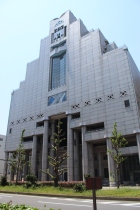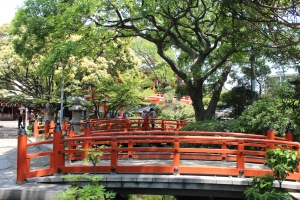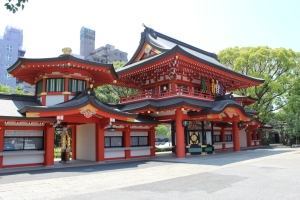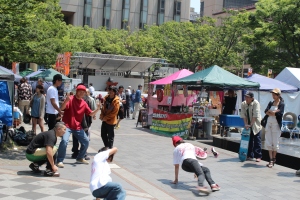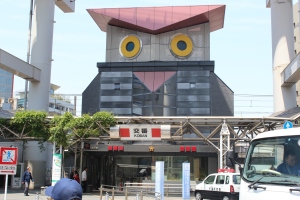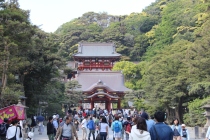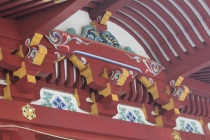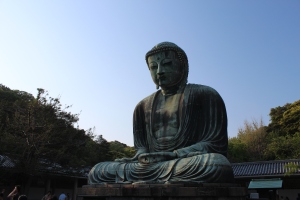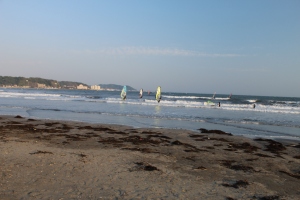in golden week deliver
all our varied goals?
Monday 6 May
This is a public holiday and golden week when all Japan is on the vacation move. So we elect to travel to Chiba in search of the Ushiku prints that are reportedly in their collection. Chiba is a prefecture to the east of Tokyo and takes about an hour by train. On the way we pass through Funabashi where Murakami used to live so there’s a Haruki element as well as an art quest in today’s schedule. The second part of the day involves a trip to Kamakura to see the famous bronze Buddha – Daibutsu. That’s about an hour south west of Tokyo so during the day we’ll make a big triangle around Tokyo Bay.
It’s a fine and sunny day again with Hokkaido snow a faint memory. The train is on time of course – we have seen a couple of apology notices for delay in trains displayed on their LCD screens. “passenger injury” was one; “smoking on the track” the other. We do stop at Funabashi but there’s no time to get off and explore. Chiba is a pleasant city and the Art Museum is in an amazing building which also houses City Hall. As is so often the case with the majority of museums and galleries they confirm that they have his work but regret that it’s not on display because of special exhibitions which of course bring in visitors and money. They also kindly confirm with their colleagues at the Sakura Museum that the Ushikus that they have are also not on display so we are saved an extra trip there.
What we do see however is a painting very like some other watercolours we have at home which I bought on the same trip thirty years ago. He is Sagai Hoitsu an important member of the Rimpa movement. I’ll do more research on those when we get back – I’d thought they were Chinese but the similarity in technique and subject matter make me think I might have displayed a degree of taste in my purchases all those years ago.
In chatting to the helpful ladies in the museum shop we discuss hanko and hon as there’s a sample one which has photographs and narrative alongside the shrine and temple stamps. I admired it and showed it to Dee and discovered that one of the ladies had actually compiled it for real on a trip to Izu prefecture. She then suggested we visit Chiba’s shrine which we do and it is very beautiful and has a memorial gathering and some baby ceremonies which we would refer to as christenings but need to find out what they are actually called.
Back to the station via Chuo Park where music, dance and food stalls are out in force to celebrate the holiday. There’s a very festive atmosphere which leaves us with a brief but fond impression of Chiba. They also have a fun way with police boxes.
We are fortunate to find on arrival that there’s a train which goes through Kamakura without us needing to change in Tokyo as we had expected. So we settle down for a fascinating ride through the suburbs, a little countryside and the cities of Tokyo and Yokohama before we reach Kamakura and can smell if not see the sea. Our journey musings are rudely interrupted by the ingress of a group of ten year old soccer players who were keen to try out their English. Great fun and some lovely lads who took the mickey out of Eric who was part-English but wouldn’t speak to us.
On arrival in Kamakura, our first trip is through Shopping Town to the Tsurugaoka Hachimangu Shrine. It never fails to surprise me how the route to sacred sites is always lined with hundreds of retail and food outlets. We finally make to the shrine – an important site in a lovely setting in wooded hills above the town. It’s a real struggle to make progress through the streets as the Japanese on holiday have only two speed settings – amble and dawdle. Our thrusting western strides are frequently forced to a shuffle as blocks of ditsing humanity prevent our progress.
The shrine is great and we then make our way back down to the station and take a further branch line train two stops down the line to Hase the station for the giant Buddha. I need to check my photographs from 30 years ago but my recollection is of this huge and beautiful bronze statue standing alone in a clearing in the woods, not surrounded by buildings as it is now. The Buddha is still as wondrous as it was then – 35 metres high, symmetrical in form and smiling enigmatically clasping the most wonderfully moulded hands. It’s 700 years old too.
We leave the Buddha and walk to the beach where waves are pounding the shore and people are enjoying surfing and windsurfing in what are obviously quite difficult conditions given the number of crashes. We walk along the beach back towards Kamakura when I suggest that if we turn left we’ll come to the station before Hase and can then go back to Kamakura from there. My companion expresses some doubt and is pleasantly surprised when my sense is vindicated. It’s a one track station so has only one platform. It is suggested that we get on the next train down to Hase anyway, stay on it and be sure of a seat. Not such a good plan as there are a further four stations after Hase! So we wait at Hase again and then re-board the train for Kamakura and then onto a JR train back to Shinjuku. Dinner is in a fine shoes-off restaurant Imaya in the centre of Shinjuku. Again a few new taste experiences were on offer: gingko nuts, smoked radish, and chicken thighs with pickled ginger shoots which came with a warning not to eat the red bit.


